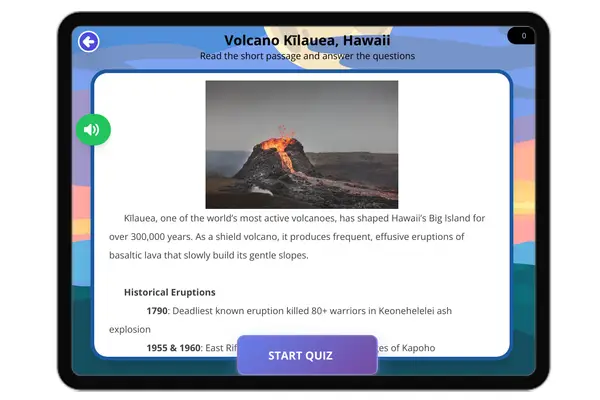What Is the Difference Between Magma and Lava? — Reading Comprehension
Premium Resource
Grades
- 5
- 6
- 7
- 8
Standards
- MS-ESS2-3
- MS-ESS3-2
- RST.6-8.4
PRINT+DIGITAL RESOURCE
This learning resource is available in interactive and printable formats. The interactive worksheet can be played online and assigned to students. The Printable PDF version can be downloaded and printed for completion by hand.
About This Reader
This educational reading passage explains the critical difference between magma and molten rock beneath Earth's surface and lava that has erupted onto the surface. Written with easy comprehension (appropriate for middle school), the passage uses relatable comparisons to help students understand volcanic processes. The content aligns with NGSS standard MS-ESS2-3 (Earth's Systems) by exploring how materials within Earth's systems are changed through natural processes. The passage covers key concepts including: how magma forms in the mantle and crust, what happens when magma reaches the surface and becomes lava, different types of igneous rocks that form based on cooling rates, and why understanding these differences matters for scientific predictions. The accompanying 8 multiple-choice questions assess student comprehension of main ideas, vocabulary, and key details in alignment with Common Core Reading Informational Text standards. This resource serves as an excellent introduction to volcanic processes within the broader context of plate tectonics and Earth's internal systems."
Perfect For:
👩🏫 Teachers
- • Reading comprehension practice
- • Auto-graded assessments
- • Literacy skill development
👨👩👧👦 Parents
- • Reading practice at home
- • Comprehension improvement
- • Educational reading time
🏠 Homeschoolers
- • Reading curriculum support
- • Independent reading practice
- • Progress monitoring
Reading Features:
📖
Reading Passage
Engaging fiction or nonfiction text
❓
Comprehension Quiz
Auto-graded questions
📊
Instant Feedback
Immediate results and scoring
📄
Printable Version
Download for offline reading




















